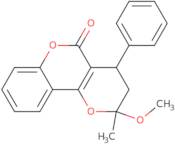Pyranocoumarin
CAS: 518-20-7
Ref. 3D-FP157978
| 25mg | Discontinued | ||
| 50mg | Discontinued | ||
| 100mg | Discontinued | ||
| 250mg | Discontinued | ||
| 500mg | Discontinued |
Product Information
- 2-Methyl-2-methoxy-4-phenyl-5-oxodihydropyrano[3,2-c][1]benzopyran
- 2-methoxy-2-methyl-4-phenyl-3,4-dihydro-2H,5H-pyrano[3,2-c]chromen-5-one
- 2H,5H-Pyrano[3,2-c][1]benzopyran-5-one, 3,4-dihydro-2-methoxy-2-methyl-4-phenyl-
- 2H-Pyran-5-carboxylic acid, 3,4-dihydro-6-(o-hydroxyphenyl)-2-methoxy-2-methyl-4-phenyl-, δ-lactone
- 3,4-(2′-Methyl-2′-methoxy-4′-phenyl)dihydropyranocoumarin
- 3,4-Dihydro-2-methoxy-2-methyl-4-phenyl-2,5-pyrano[3,2-c][1]benzopyran-5-one
- 3,4-Dihydro-2-methoxy-2-methyl-4-phenyl-2H,5H-pyrano[3,2-c][1]benzopyran-5-one
- 4-Hydroxycoumarin anticoagulant no. 63
- Anticoagulans 63
- Anticoagulant No. 63
- See more synonyms
- Cumopyran
- Cumopyrin
- Cyclocoumarol
- Cyclocumarol
- Methanopyranorin
- Methopyranorin
- BL 5
Pyranocoumarin is a potent inhibitor of human pharmacokinetics. It inhibits the activity of receptor proteins by binding to the active site and blocking the binding site for the drug. Pyranocoumarin has been shown to be an inducer of bowel disease in rats. This drug also activates signal pathways that regulate gene expression and mitochondrial membrane potential, leading to increased cell proliferation and inhibition of apoptosis in carcinoma cell lines. The analytical method used for pyranocoumarin is high-performance liquid chromatography (HPLC). HPLC analysis found that pyranocoumarin was present in cardiac muscle tissue, indicating that it may have a cardiotoxic effect on cardiac muscles.





